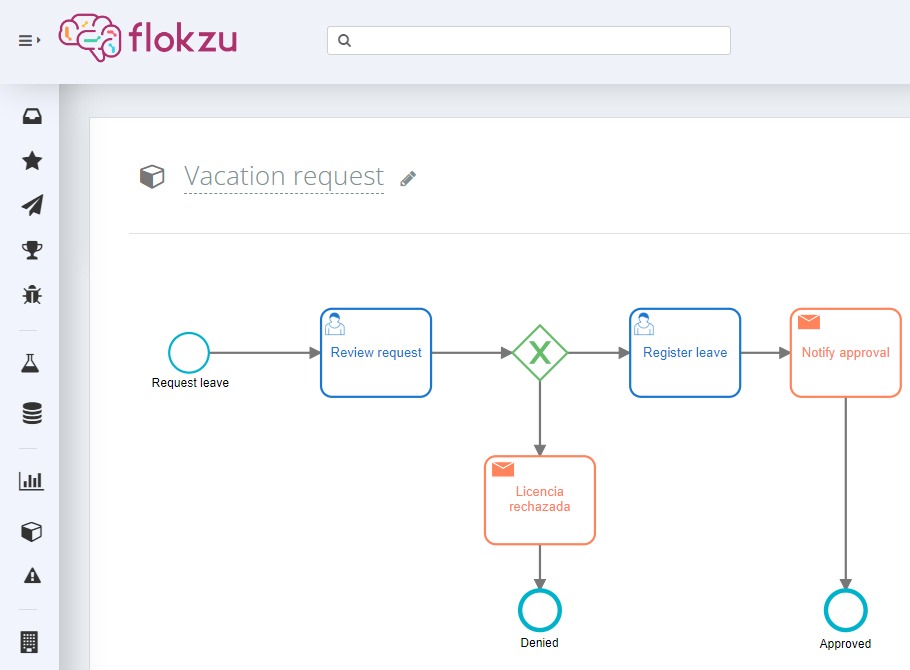Introduction
In the complex landscape of business process management, one thing is clear: there is no one-size-fits-all solution. Real-world processes vary in nature and complexity, requiring specific tools to maximize efficiency. For some, an agile and visual solution like Kanban may be the answer, facilitating collaboration and workflow visualization. For others, especially in enterprise environments where complexity and scalability are imperative, a more rigorous approach like BPM (Business Process Management) is essential.
In this article, we will delve into two prominent approaches: Flokzu, a powerful BPM Suite, and a series of Kanban tools along with other alternatives. Flokzu has established itself as a leader in managing complex processes, offering a comprehensive solution to address the most intricate business challenges. However, it’s worth recognizing that for simpler processes with limited participants, Kanban tools like Monday and Trello, as well as solutions like Asana and Airtable, can provide an effective short-term response.
Throughout these pages, we will break down the ideal scenarios for each approach and provide a detailed analysis of their capabilities and limitations. From the simplicity of Kanban to the robustness of BPM, each tool has its place in the process management arsenal. In this article, we aim to provide the clarity and guidance needed to make informed decisions about which solution aligns best with your organization’s needs.
Flokzu in Action
Flokzu, a Business Process Management Suite (BPMS) with an exceptionally powerful focus, stands out for its ability to address a wide range of processes, from the most intricate to the simplest and linear ones.
Powerful Solutions for Simple Processes
The value of automation in seemingly simple and linear processes is often underestimated. However, in these scenarios, Flokzu shines brightly. Consider a process where each task is executed sequentially, one after another, following a logical and clear flow. At first glance, such a process may seem straightforward and easy to manage manually. However, this is where Flokzu proves its worth.
Take, for example, the process of requesting leaves of absence. At first glance, it may seem like a straightforward operation. The employee submits the request, the supervisor approves it, and then the attendance record is updated. However, in practice, even the most linear processes like this can become confusing and error-prone when managed manually.

An unmatched advantage of a process tool is to provide visibility into the process, its rules, possible paths, in a clear and intuitive way for anyone who needs to know it.
By implementing this process in Flokzu, each step becomes clear, measurable, and controllable. Automatic notifications ensure that no one forgets their responsibility, and deadlines are kept in check. Furthermore, the detailed history of each task provides complete traceability, meaning that at any given moment, you can review who did what and when.
But the greatest advantage becomes apparent as this process evolves. With Flokzu, optimization is not just a possibility; it’s a promise kept. Small improvements can be easily implemented without disruptions, ensuring that even the simplest processes remain efficient and effective over time.
The Importance of Formal Processes, Even When Simple
Even in apparent simplicity, such as requesting leaves of absence, the formalization and modeling of processes play a crucial role in organizational management. Let’s see why:
Clarity and Consistency
Formalizing a simple process means establishing a clear and consistent standard. Everyone involved understands the steps, responsibilities, and deadlines. This ensures that each leave request is handled consistently, regardless of who is in charge.
Frictionless Scalability
As the organization grows, the number of requests is likely to increase. A formalized process scales easily. Whether you have 10 or 1000 employees, each follows the same workflow, ensuring efficient and smooth handling.
Regulatory and Legal Compliance
In business environments, compliance with regulations and policies is essential. A formalized process ensures that each stage complies with relevant legal and regulatory requirements. This provides a layer of protection for both the company and employees.
Adaptation to Future Changes
As business needs evolve, processes inevitably change. With a formal model in place, changes are introduced in a structured and controlled manner. You can assess the impact, communicate updates, and ensure that everyone is aware of the modifications.
Streamlined Onboarding
When new team members join, having a formalized process greatly facilitates their integration. There’s no confusion about what’s expected from them or from others. The process is outlined clearly and ready to be followed.
Analysis and Continuous Improvement
A formalized process provides a solid foundation for data collection and performance measurement. This allows for the identification of areas for improvement and optimization. With concrete data in hand, decisions are based on facts, not assumptions.
In the process management universe, Kanban-based tools offer a visual and agile perspective for organizing tasks and workflows. Next, we’ll explore what the vacation request process would look like using this approach, and then delve into two popular alternatives: Monday.com and Trello
Kanban-Based Alternatives
Vacation Process in Kanban
In a Kanban board, the vacation request process would be represented as follows:

The implementation of this board depends on the chosen tool but always involves moving cards from one stage to another, without business rules or controls, as seen in the illustration below.

The movement of cards is manual and does not consider or enforce business rules. In other words, it depends on the person to move the card to the correct column, rather than a formal organizational rule.
Likewise, it’s evident that in a process with many stages, control and task tracking in a Kanban scheme become extremely complex and error-prone.
While some tools support automations like “Move the card to column X if condition Y occurs,” this configuration is cumbersome and not highly visible since it’s not represented in a process diagram, but configured within the tool. It’s not programming, but it’s similar in the sense that business rules are challenging to identify and maintain in the future when they need to change.
Let’s take a closer look at three of the most widely used tools: Trello, Monday.com, and Asana.
Monday.com
Monday.com is a team collaboration and project management platform that organizes tasks and facilitates business collaboration.
Benefits:
- Visual and Intuitive Interface: Monday.com offers a visually appealing user experience, making it easy to understand and track processes.
- Advanced Customization: It allows for a high degree of customization, adapting to the organization’s specific requirements.
- Effective Collaboration: Encourages collaboration and communication among team members.
Limitations:
- Impractical for Complex Processes: As processes become more complex, Monday.com may not be as suitable as a BPM solution. It is impossible to model conditional, parallel, or exclusive flows with alerts, interruptions, etc.
- It’s not easy to include business rules for moving cards between stages. For example, if there’s a rule in your organization that says “all leaves exceeding 30 days must be approved by the Manager,” you won’t be able to formalize it and be confident that it will always be applied. It will depend on each person evaluating the requested leave, whether to send it to the Manager or not.
- Management of process versions: As your company grows, processes will need to evolve, so it will be necessary to define new versions of processes, test them, and finally make them available. Additionally, this procedure and its audit trail will be important for an auditor.
Trello
Trello is a visual project management platform that organizes tasks into cards for teams, making collaboration easy.
Benefits:
- Ease of Use: It is very easy to set up and use, making it ideal for teams looking for a quick and simple solution.
- Flexibility: Trello can adapt to different types of processes.
- Abundant Integrations: It has a wide range of integrations with other popular tools.
Limitations:
- Informality: It is not possible to define a process diagram to ensure that it always works the same way (e.g., with a BPMN diagram).
- Limited Scalability: As the organization grows, and there are many ongoing process instances, Trello cards become uncomfortable and less usable.
- Lack of Visibility: As processes become more complex, Trello does not offer a graphical way to view, analyze, and discuss them for improvement.
Asana
Asana is a specialized project management platform designed to help organizations plan, organize, and track projects and tasks.
Benefits:
- Transparent Collaboration: Asana facilitates team collaboration by providing a centralized space for communication and task management.
- Effective Tracking: Offers a wide variety of tools for detailed project progress and status tracking.
- Versatile Integrations: Easily integrates with a wide range of productivity tools and enterprise software.
Limitations:
- Less Structured Process Management: Although Asana excels in task management, it may be less suitable for highly structured and formalized workflows.
- Not suitable for processes from other areas (such as HR, for example), so its scope is limited to project execution, necessitating the incorporation of another tool.
- Inability to graphically diagram processes, for documenting, discussing with the team, presenting to an external auditor, etc.
Summarizing Kanban vs. BPM
Compared to Flokzu, both Monday.com and Trello excel in ease of use. However, when it comes to real-world processes with complexity, conditional flows, alerts, versioning, etc., they fall short.
An important corollary is that once a tool like Trello, Monday.com, or Asana is in use, and users have become accustomed to it, changing becomes very difficult. This leads to a medium-term problem that is difficult to resolve when it is clear that a more powerful tool is needed, but the necessary change management is costly and time-consuming.
If you believe that your organization will grow and that you will onboard new people and new processes, it is recommended to use a robust, powerful process management solution from day one to support long-term growth.
Tools for Building Applications
In this journey through process management tools, we cannot overlook two important players: Airtable and Bubble. Although they are not directly related to process management, they deserve special mention for their ability to build custom applications.
Airtable
Airtable is a platform that allows you to create custom and flexible databases. While it provides great versatility for managing data, building complete applications in Airtable often requires a high degree of technical knowledge. Additionally, the time needed to develop an application in Airtable can be considerable.
Bubble
Bubble presents itself as a no-code application development tool. However, its learning curve is steep, and creating complex applications requires a substantial level of technical knowledge. Building an application in Bubble can also be a slow and challenging process.
Specialization in Process Management
This is where Flokzu significantly differs. Specifically designed for process management, Flokzu is accessible even to business analysts without deep technical expertise. It allows for efficient and quick modeling, automation, and measurement of processes without the need for extensive programming or complex technical configurations as required by Airtable and Bubble.
Additionally, it’s essential to highlight that manual application building, whether in Airtable, Bubble, or other platforms, is often a slow and laborious process. It requires a significant investment of time and resources. Moreover, maintaining these custom applications can be costly and complex as business needs evolve.
Lastly, it’s important to emphasize that no manually built application can match the quality, power, and reliability of a BPM tool like Flokzu for effective business process automation. BPM tools are specifically designed for this task and offer a robust and proven solution for efficient process management.
Additional Reading: Software Development vs. Using a BPM Suite
Conclusions
Throughout this exploration of various task, process management, and application-building tools, it becomes clear that selecting the right platform largely depends on an organization’s specific needs and capabilities.
Flokzu emerges as a highly effective and accessible solution for automating business processes. Its user-centric approach, combined with an intuitive interface, allows business analysts to model and manage processes efficiently without requiring deep technical knowledge.
In contrast, tools like Airtable and Bubble offer flexibility and customization but at a high cost of complexity and development time. They require a significant level of technical skills and can pose considerable challenges in terms of maintenance and long-term scalability.
On the other hand, platforms like Monday.com, Trello, and Asana are valuable for project management and team collaboration. However, they are designed for a different purpose and do not provide the same power and flexibility as a BPM tool like Flokzu when it comes to real-world process automation and rigorous workflow management.
Ultimately, the choice between these tools should be carefully considered based on the specific goals, budgets, and requirements of each organization. Flokzu stands out as the alternative that balances the power of BPM with accessibility for business users, offering a comprehensive and effective solution for managing business processes.




























